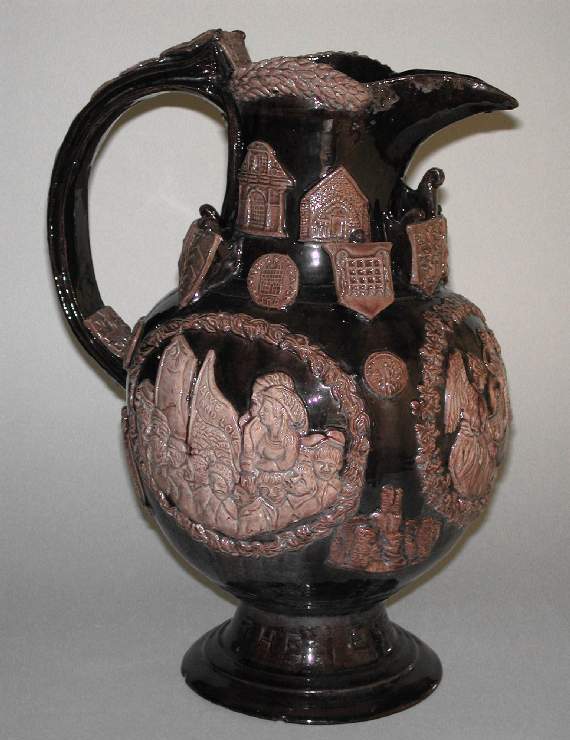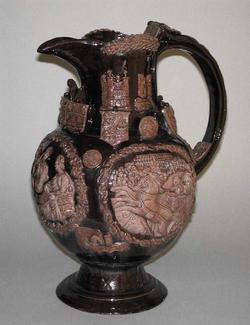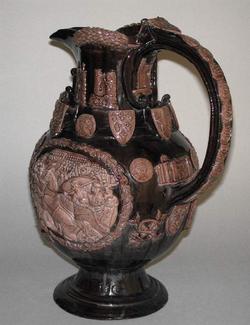Current Location: In storage
Titles
The Essex Jug
Maker(s)
Potter:
Bingham, Edward
Castle Hedingham Pottery
Entities
Categories
Description
Red earthenware jug with applied, moulded, white earthenware reliefs and manganese-brown glaze.
Globular body with tall, narrow neck, projecting lip and scroll loop handle, sitting on a circular, roughly conical, base. The jug is covered with applied reliefs: three large, narrative medallions to the sides, surrounded by wreaths of hops and saffron and with coins, castles and an ‘S’ emblem in between. The central medallion is inscribed ‘ESSEX’, the one on its left ‘LIVE AND LOVE’. Seven heraldic shields and two coins are mounted on projections around the shoulders; five castles and churches are applied around the neck. The handle is decorated with oysters and shields, and the neck rim with wheat. ‘THE ESSEX JUG’ is incised around the collar of the base. Each side of the handle is deeply incised. The underside is recessed and glazed.
Notes
History note: Made by Edward Bingham for Dr Glaisher, Trinity College, Cambridge, c.1896.
Legal notes
Dr. J.W.L. Glaisher Bequest, 1928
Measurements and weight
Height: 37 cm
Height: 14.5 in
Width: 28 cm
Width: 11 in
Acquisition and important dates
Method of acquisition: Bequeathed
(1928)
by
Glaisher, J. W. L., Dr
Dating
19th Century, Late
Victorian
Production date:
circa
AD 1896
: (noted on Dr Glaisher's label)
Note
'The Essex Jug' was made in different sizes, and various shades of brown; the decoration is not identical. Bingham used well-fired clay and plaster moulds for his relief designs, which were sometimes coloured. The central medallion shows ‘Essex’ displaying herself to ‘curiosity’ and ‘agriculture’. The side medallion to the right of this shows Boadicea’s victory over the Roman Legion, and the medallion on the left a procession linked to the Dunmow Flitch trials. This ancient tradition, mentioned in Chaucer’s ‘Wife of Bath’s Tale’, awards a flitch of bacon to married couples who can prove they have 'not wisht themselves unmarried again' for more than twelve months. Great Dunmow, home of the trials, is 17 miles from Castle Hedingham. The smaller reliefs represent well known Essex buildings, the arms of various towns and Essex families, and Roman coins.
Edward Bingham (1829- 1914) was the son of a Lambeth potter who mainly produced functional wares. The business moved first to Gestingthorpe, Essex, and then in 1837 to Castle Hedingham. From c.1864 Edward Bingham produced ornamental ware, drawing on mediaeval and Tudor styles and notable for its size and exuberant relief decoration, which often includes modeled animals, birds or faces. He used the local terracotta and, later, clay from Devon. Until the mid 1870s, most Hedingham ware was unglazed, and Bingham supplemented income through various other work, variously as a shoe-maker, teacher, sub-postmaster and ironmonger. The pottery was most successful between c.1875-85, with up to 13 kilns operating, but afterwards trade flagged and in 1901 the business was sold, though it continued to operate as ‘The Essex Art Pottery’ until 1905. Bingham continued to make pots there, and then for a few months in a temporary workshop, before emigrating to join his family in North America in 1906.
This jug was made for Dr Glaisher, who also bought several other pieces including another jug like it from the potter himself, c.1896. He later bought a modeled crocodile figure (Fitzwilliam collection, C.98-1928) and some twenty other pieces on two visits to the closed pottery, and one to a London showroom, in July 1907. He notes the best of Bingham’s work as ‘ambitious and characteristic work as regards the design modelling’ and ‘really fine and would do justice to any potter’, although he also records several examples of glazing failures.
People, subjects and objects depicted
Components of the work
Decoration
composed of
white earthenware
Materials used in production
Lead-glaze
Red earthenware
Techniques used in production
Throwing
: Red earthenware jug with applied white earthenware reliefs and lead-glazed.
Inscription or legends present
- Text: No. 783 / The Essex Jug / Made for me by Bingham at Castle Hedingham about 1896
- Location: Underside of base
- Method of creation: Rectangular paper label, inscribed in black ink
- Type: Label
References and bibliographic entries
Related exhibitions
Identification numbers
Accession number: C.99-1928
Primary reference Number: 76503
Stable URI
Audit data
Created: Saturday 6 August 2011
Updated: Wednesday 15 July 2020
Last processed: Tuesday 15 July 2025
Associated departments & institutions
Owner or interested party:
The Fitzwilliam Museum
Associated department:
Applied Arts







